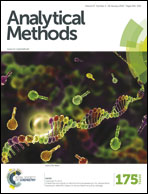Selective micro solid-phase extraction of epinephrine, norepinephrine and dopamine from human urine and plasma using aminophenylboronic acid covalently immobilized on magnetic nanoparticles followed by high-performance liquid chromatography-fluorescence detection†
Abstract
Aminophenylboronic acid-functionalized magnetic nanoparticles were synthesized by a facile method for the selective micro solid-phase extraction of norepinephrine, epinephrine and dopamine. After extraction, HPLC with fluorescence detection was used for the determination of the analytes in human urine and plasma. The effects of experimental parameters such as the sorbent amount, sample pH, extraction and desorption conditions on the extraction efficiency of the sorbent were investigated. The selectivity of the sorbent was also evaluated. The linearity range of the method was 0.04–10 ng mL−1 for norepinephrine and epinephrine, and 0.06–25 ng mL−1 for dopamine. The recovery of the analytes was in the range of 96.8–97.5% and 86.3–88.1% for urine and plasma samples, respectively. Also, the relative standard deviations were in the range of 3.0–4.5% and 4.0–5.0% for urine and plasma, respectively. The limits of detection were 0.01, 0.01 and 0.02 ng mL−1 for norepinephrine, epinephrine and dopamine, respectively.


 Please wait while we load your content...
Please wait while we load your content...